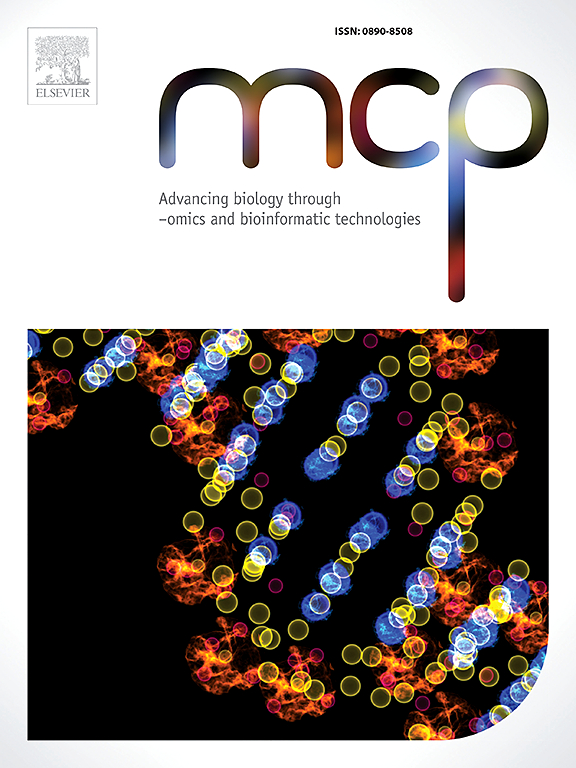CPLX1表达作为结直肠癌潜在预后标志物的鉴定。
IF 3
3区 生物学
Q3 BIOCHEMICAL RESEARCH METHODS
引用次数: 0
摘要
目的:CPLX1是络合蛋白/突触蛋白家族的一员。研究表明CPLX1参与肿瘤进展。然而,CPLX1参与结直肠癌(CRC)的生物学机制尚不清楚。方法:TIMER和TCGA数据库提供CPLX1 mRNA在泛癌和结直肠癌中的差异表达。我们收集90例结直肠癌及其邻近正常组织进行免疫组化(IHC),研究CPLX1蛋白表达及其与临床信息的相关性。采用Cox回归和Kaplan-Meier法确定CPLX1表达的预后价值。我们利用Spearman分析来探讨CPLX1与免疫细胞浸润、免疫检查点的关系。我们利用GSEA研究了CPLX1在CRC中的生物学分子功能。结果:CPLX1 mRNA在包括CRC在内的多种癌症中表达升高。在CRC样本中,IHC证实CPLX1蛋白表达升高,并与T期呈正相关。生存分析表明,CPLX1过表达与CRC较差的总生存期(OS)、疾病特异性生存期(DSS)和无进展间隔(PFI)有关。时间ROC分析显示,OS、DSS、PFI的1年、2年、3年生存率均在0.5以上,提示对CRC有一定的预后价值。Cox回归认为CPLX1表达是预测OS、DSS和PFI的良好预后指标。此外,CPLX1的表达与CRC的免疫有关。功能分析显示CPLX1相关基因参与Notch信号通路。结论:CPLX1是CRC的潜在预后和诊断标志物,也可能是潜在的治疗靶点。本文章由计算机程序翻译,如有差异,请以英文原文为准。
Identification of CPLX1 expression as a potential prognostic marker in colorectal cancer
Objectives
CPLX1 is a member of the complexin/Synaphin family. Studies have shown that CPLX1 is involved in tumor progression. However, the biological mechanism by which CPLX1 is involved in colorectal cancer (CRC) is unclear.
Methods
TIMER and TCGA database provided difference expression of CPLX1 mRNA in pan-cancer and CRC. We collected 90 cases of CRC and adjacent normal tissues for immunohistochemistry (IHC) and investigated CPLX1 protein expression and its correlation with clinical information. Cox regression and Kaplan–Meier were conducted to determine prognostic value of CPLX1 expression. We utilized Spearman analysis to explore the association between CPLX1 and immune cell infiltration, immune checkpoints. We utilized GSEA to investigate the biological molecular function for CPLX1 in CRC.
Results
CPLX1 mRNA expression was elevated in several cancers, including CRC. Elevated CPLX1 protein expression was confirmed by IHC in CRC samples, and showed a positive association with T stage. The survival analysis demonstrated that CPLX1 overexpression was linked to a poorer overall survival (OS), disease-specific survival (DSS), and progress-free interval (PFI) for CRC. Time ROC analysis suggested that the survival rate of 1-year, 2-year and 3-year for OS, DSS, and PFI was above 0.5, suggesting a certain prognostic value in CRC. Cox regression considered CPLX1 expression as a good prognostic index for predicting OS, DSS, and PFI. Furthermore, CPLX1 expression was associated with immunity in CRC. Functional analysis showed that CPLX1 related genes had participation in Notch signaling pathway.
Conclusions
CPLX1 was a latent prognostic and diagnostic marker for CRC and may also be a potential therapeutic target.
求助全文
通过发布文献求助,成功后即可免费获取论文全文。
去求助
来源期刊

Molecular and Cellular Probes
生物-生化研究方法
CiteScore
6.80
自引率
0.00%
发文量
52
审稿时长
16 days
期刊介绍:
MCP - Advancing biology through–omics and bioinformatic technologies wants to capture outcomes from the current revolution in molecular technologies and sciences. The journal has broadened its scope and embraces any high quality research papers, reviews and opinions in areas including, but not limited to, molecular biology, cell biology, biochemistry, immunology, physiology, epidemiology, ecology, virology, microbiology, parasitology, genetics, evolutionary biology, genomics (including metagenomics), bioinformatics, proteomics, metabolomics, glycomics, and lipidomics. Submissions with a technology-driven focus on understanding normal biological or disease processes as well as conceptual advances and paradigm shifts are particularly encouraged. The Editors welcome fundamental or applied research areas; pre-submission enquiries about advanced draft manuscripts are welcomed. Top quality research and manuscripts will be fast-tracked.
 求助内容:
求助内容: 应助结果提醒方式:
应助结果提醒方式:


